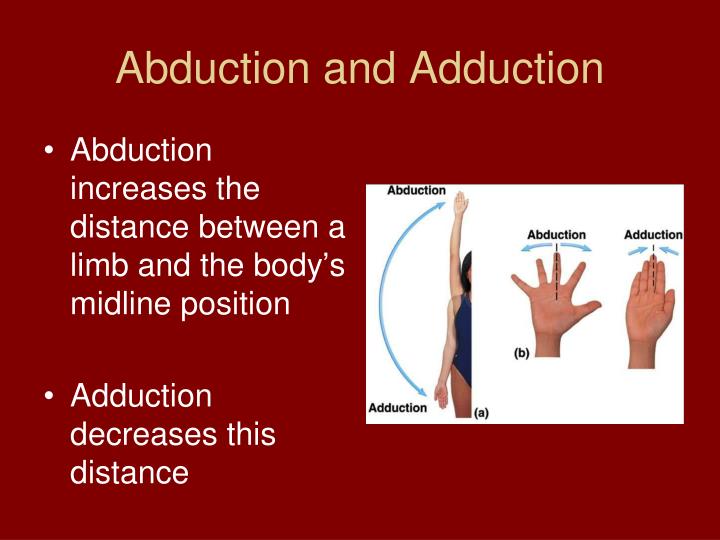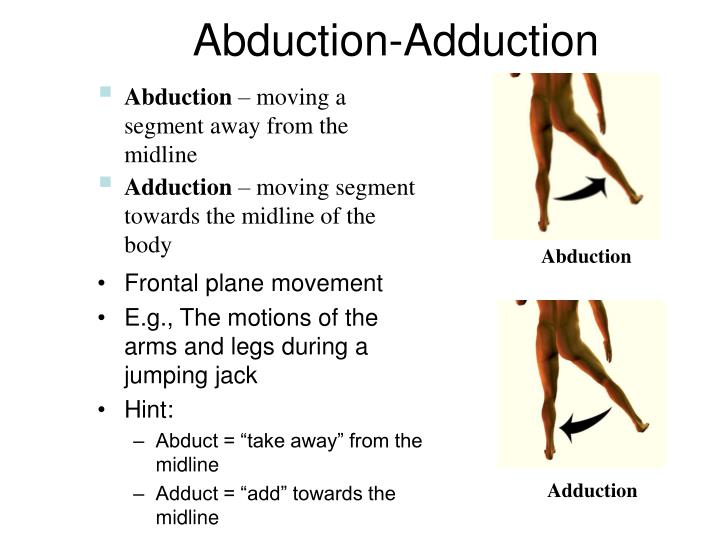Adduction vs. Abduction: A Basic Overview
Adduction and abduction are two fundamental human movements that play a crucial role in our daily lives and overall physical health. Adduction refers to the motion of drawing a limb toward the midline of the body, while abduction is the opposite movement, involving moving a limb away from the midline. Understanding the differences and similarities between adduction and abduction can help individuals improve their exercise techniques, prevent injuries, and enhance their overall movement quality. This comprehensive article will delve into a detailed comparison of adduction versus abduction, shedding light on their unique aspects and shared characteristics.
What is Adduction? A Closer Look
Adduction is a specific type of human movement that involves bringing a limb or any other body part towards the midline of the body. In simpler terms, it is the action of moving a part of the body closer to the center from an extended or abducted position. This movement is essential for maintaining balance, stability, and overall functionality in daily activities and various physical exercises.
For instance, when you stand with your feet hip-width apart and then bring your heels closer together, you are performing adduction with your legs. Similarly, when you perform a bicep curl with a dumbbell, the movement of the weight towards your shoulder as you bend your elbow is also an example of adduction.
Incorporating adduction exercises into your fitness routine can help improve overall strength, flexibility, and injury prevention. For example, exercises like the adductor squeeze, sumo squats, and side-lying leg lifts target the adductor muscles, which are responsible for adduction movements. These exercises can help improve your stability, balance, and range of motion, especially in activities that require quick changes in direction or lateral movements.
What is Abduction? Understanding the Movement
Abduction is a type of human movement that involves moving a limb or any other body part away from the midline of the body. In simpler terms, it is the action of moving a part of the body farther apart from the center. Abduction plays a crucial role in maintaining balance, stability, and overall functionality in daily activities and various physical exercises.
For instance, when you stand with your feet hip-width apart and then spread your feet wider, you are performing abduction with your legs. Similarly, when you perform lateral raises with dumbbells, moving your arms away from your body, you are performing abduction in your shoulders.
Incorporating abduction exercises into your fitness routine can help improve overall strength, stability, and range of motion. Exercises like lateral band walks, side leg lifts, and seated abductions target the abductor muscles, which are responsible for abduction movements. These exercises can help improve your balance, stability, and functionality, especially in activities that require lateral movements or quick changes in direction.
Similarities Between Adduction and Abduction: Shared Characteristics
Adduction and abduction are two fundamental movements in human anatomy, and they share several similarities. Both adduction and abduction are essential for maintaining balance, stability, and overall functionality in daily activities and various physical exercises. They work together to ensure a full range of motion and proper alignment of the body.
One of the primary similarities between adduction and abduction is their role in human movement. Both movements involve moving a limb or any other body part in opposite directions concerning the midline of the body. Adduction moves a body part towards the midline, while abduction moves it away from the midline. This back-and-forth movement helps maintain balance and stability, allowing individuals to perform various physical activities with ease and precision.
Another shared characteristic of adduction and abduction is the relationship between agonist and antagonist muscles. Agonist muscles are responsible for the primary movement, while antagonist muscles work in opposition to the agonist muscles. In adduction and abduction movements, when the agonist muscles contract to move a limb towards or away from the midline, the antagonist muscles relax. This coordinated muscle activity ensures smooth and controlled movements, reducing the risk of injury and improving overall movement quality.
Differences Between Adduction and Abduction: Key Distinctions
While adduction and abduction share some similarities, they also have distinct differences that are essential to understand. Recognizing these differences can help individuals improve their exercise techniques, overall movement quality, and reduce the risk of injury.
One of the primary differences between adduction and abduction is the direction of movement. Adduction involves moving a limb or body part towards the midline of the body, while abduction involves moving it away from the midline. This fundamental difference in direction affects the muscles involved, the range of motion, and the overall functionality of the movements.
Another key distinction between adduction and abduction is the muscles primarily engaged in each movement. For example, during adduction, the adductor muscles in the hips or inner thighs are the primary movers. In contrast, during abduction, the abductor muscles in the hips or outer thighs are responsible for the movement. Understanding which muscles are engaged in each movement can help individuals target specific muscle groups, improve strength and flexibility, and prevent muscle imbalances.
Lastly, adduction and abduction can have different implications for injury prevention and rehabilitation. For instance, individuals recovering from hip or shoulder injuries may need to perform specific adduction or abduction exercises to regain strength, stability, and range of motion. In such cases, understanding the differences between these movements can help individuals and healthcare professionals develop targeted exercise programs to support recovery and prevent future injuries.
How to Incorporate Adduction and Abduction in Your Fitness Routine
Incorporating adduction and abduction exercises into your fitness routine can offer numerous benefits, including improved overall strength, flexibility, and injury prevention. Here are some practical tips and examples to help you target these movements effectively.
1. Consult a fitness professional: Before starting any new exercise routine, consult with a fitness professional or certified personal trainer. They can help assess your current fitness level, identify any potential risks or limitations, and provide personalized advice on incorporating adduction and abduction exercises into your workouts.
2. Include a variety of exercises: To ensure a balanced and comprehensive fitness routine, include a mix of exercises that target adduction and abduction movements. Some examples include:
- Adduction exercises: Side-lying leg lifts (targeting the inner thighs), sumo squats, and adductor machine exercises.
- Abduction exercises: Side leg lifts (targeting the outer thighs), clamshells, lateral band walks, and abduction machine exercises.
3. Balance intensity and volume: Aim for a balanced approach when incorporating adduction and abduction exercises into your workouts. This means varying the intensity, volume, and frequency of these exercises to ensure proper progression and avoid overloading your muscles or joints.
4. Prioritize proper form and alignment: Maintaining proper form and alignment is crucial when performing adduction and abduction exercises. This helps ensure that you are targeting the correct muscle groups and minimizing the risk of injury. Focus on engaging your core muscles, keeping your spine neutral, and moving through a full range of motion.
5. Incorporate adduction and abduction exercises into your warm-up and cool-down routines: Including these movements in your warm-up and cool-down can help prepare your muscles and joints for more intense exercise and promote recovery. Examples include dynamic stretches like leg swings, lunges with lateral movements, and foam rolling techniques that target the inner and outer thighs.
Common Misconceptions and Mistakes in Adduction and Abduction
When performing adduction and abduction exercises, it’s essential to be aware of common misconceptions and mistakes that can lead to improper technique and potential injuries. Here, we address some of these issues and provide guidance on maintaining proper form and alignment.
1. Neglecting opposing muscle groups
Adduction and abduction movements often involve opposing muscle groups, known as agonist and antagonist muscles. Failing to train both muscle groups can result in muscle imbalances and reduced movement quality. Ensure that your fitness routine includes exercises that target both adduction and abduction movements.
2. Overlooking proper form and alignment
Maintaining proper form and alignment is crucial when performing adduction and abduction exercises. Improper technique can lead to injury and compromise the effectiveness of the exercises. Focus on engaging your core muscles, keeping your spine neutral, and moving through a full range of motion. If you’re unsure about the correct form for a particular exercise, consult a fitness professional or certified personal trainer.
3. Relying solely on machines
While machines can be useful for targeting specific muscle groups, relying solely on machines can limit your overall movement quality and range of motion. Incorporate bodyweight exercises, resistance bands, and free weights into your fitness routine to challenge your muscles in different ways and promote functional strength and stability.
4. Ignoring the importance of flexibility
Flexibility is an essential aspect of adduction and abduction movements. Tight muscles can limit your range of motion and increase the risk of injury. Incorporate stretching exercises and mobility work into your fitness routine to maintain and improve your flexibility. This can include dynamic stretches, static stretches, and foam rolling techniques that target the inner and outer thighs.
5. Pushing through pain
While some discomfort is expected during exercise, pushing through pain can be a sign of injury or overexertion. If you experience pain during adduction or abduction exercises, stop immediately and consult a healthcare professional. It’s essential to address any pain or discomfort promptly to prevent further injury and ensure proper recovery.
The Role of Adduction and Abduction in Everyday Life
Understanding adduction and abduction is not only important for optimizing your fitness routine but also for enhancing your overall health, well-being, and physical independence in everyday life. By incorporating these movements into your daily activities, you can improve your balance, stability, and functional strength, making it easier to perform various tasks and reducing the risk of injury.
For example, when getting in and out of a car, you use adduction and abduction movements to position your legs and maintain balance. In daily tasks like carrying groceries or lifting objects, these movements help ensure proper alignment and reduce strain on your muscles and joints. In sports and physical activities, adduction and abduction movements contribute to agility, quickness, and overall performance.
Moreover, incorporating adduction and abduction exercises into your fitness routine can help improve your posture and alignment, reducing the risk of chronic pain and discomfort in areas like the lower back, hips, and shoulders. By addressing muscle imbalances and improving your overall movement quality, you can enhance your physical capabilities and maintain your independence as you age.
In conclusion, adduction and abduction play a vital role in human anatomy and movement. By understanding the differences and similarities between these movements, incorporating them into your fitness routine, and being mindful of proper form and alignment in daily activities, you can optimize your physical health, well-being, and independence. So, explore these movements further, challenge yourself with new exercises, and make adduction and abduction a regular part of your daily routine.







